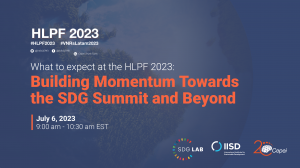 Returning to the SDGs
Returning to the SDGs
We have pointed out in the past – either through LinkedIn or in Substack posts that the Global Summitry Project (GSP) has targeted the Sustainable Development Goals (SDGs). The issue is now front and center as we enter the UN General Assembly’s return next week. The 2023 SDG Summit will take place on September 18th and 19th. It will mark the beginning of, at least according to the UN Secretary General, Antonio Gueterres, “a new phase of accelerated progress towards the Sustainable Development Goals with high-level political guidance on transformative and accelerated actions leading up to 2030”. At least that is his hope.
Early on the GSP identified this initiative as a means to assess the health of current multilateralism. First, a quick review of the SDGs:
Thanks for reading Alan’s Newsletter! Subscribe for free to receive new posts and support my work.
Subscribed
The SDGs were passed unanimously at the UN General Assembly in 2015. Agenda 2030, as it was called at the UN, identified 17 goals, 169 targets and at least 241 indicators.
These goals, targets and indicators, unlike the earlier Millennium Development Goals Initiative – the MDGs – were designed to apply not just to developing countries but to all countries, whether developing or developed. Agenda 2030 was not then just a classic development effort. This effort was, and is, a global project for all states. Achieving the SDGs is about securing global development and achieving global sustainability for all – developing, emerging market and developed economies, Global North, Global South – all. Here are the goals:
Goal 1: End poverty in all its forms everywhere
Goal 2: Zero Hunger
Goal 3: Good Health and Well-Being: Ensure healthy lives and promote well-being for all at all ages
Goal 4: Quality Education
Goal 5: Gender Equality: Achieve gender equality and empower all women and girls
Goal 6: Clean Water and Sanitation: Ensure access to water and sanitation for all
Goal 7: Affordable and Clean Energy: Ensure access to affordable, reliable, sustainable and modern energy
Goal 8: Decent Work and Economic Growth: Promote inclusive and sustainable economic growth, employment and decent work for all
Goal 9: Industry, Innovation and Infrastructure: Build resilient infrastructure, promote sustainable industrialization and foster innovation
Goal 10: Reduced Inequalities: Reduce inequality within and among countries
Goal 11: Sustainable Cities and Communities: Make cities inclusive, safe, resilient and sustainable
Goal 12: Responsible Consumption and Production: Ensure sustainable consumption and production patterns
Goal 13: Climate Action: Take urgent action to combat climate change and its impacts
Goal 14: Life Below Water: Conserve and sustainably use the oceans, seas and marine resources
Goal 15: Life on Land: Sustainably manage forests, combat desertification, halt and reverse land degradation, halt biodiversity loss
Goal 16: Peace, Justice and Strong Institutions: Promote just, peaceful and inclusive societies
Goal 17: Partnerships for the Goals: Revitalize the global partnership for sustainable development.
The ‘Two Summits’
Now we are on the case of the SDGs at the GSP. As a result we are following what are often referred to as the “Two Summits”. The first is the SDG Summit: The UN Secretary-General calls the SDG Summit [HLPF Summit, September 2023] the “centerpiece moment of 2023.” It takes place at the midpoint – completion of the first 7.5 years toward the final goal – for fully implementing the development agenda, the SDGs, adopted by countries in 2015 in 2030.
In 2024, in addition, a second Summit will take place. The UN will convene the Summit of the Future (SOTF). The theme of this Summit – ‘Multilateral Solutions for a Better Tomorrow.’ In September 2021, the Secretary-General issued a report, ‘Our Common Agenda’ urging a speed up of the implementation of the SDGSs and advancing the commitments contained in the UN75 Declaration. In some cases, the proposals addressed gaps that emerged since 2015, requiring new intergovernmental agreements. The report, therefore, called for the convening of a Summit of the Future to forge a new global consensus on readying for a future that is rife with risks but also opportunities. The General Assembly agreed to hold the SOTF Summit on September 22nd and September 23rd 2024. A ‘Pact for the Future’ is expected to be put before the UNGA and approved. The Summit’s aim is to reinforce the UN and global governance structures to better address old and new challenges and to formulate a ‘Pact for the Future’ that would help advance the SDGs by 2030.
Overall, the SOTF, it is hoped, will revitalize multilateralism and lead, possibly, to needed multilateral institutional reform and provide a convincing narrative spelling out how the SOTF can:
● foster enablers of SDG acceleration such as digitalization and access to finance;
● tackle obstacles to SDG implementation, for example, through the New Agenda for Peace, by promoting effective crisis response through the Emergency Platform, by addressing fake news, and by supporting global public goods financing;
● reinforce international standards conducive for the SDGs, including Beyond GDP, ‘longtermism’ and rights for future generations, and of course those on human rights and gender; and
● develop a more networked, inclusive, and effective UN for SDG acceleration through the Emergency Platform, Youth Office, and a biennial summit with IFIs and the G20, among others.
The Multilateral Disconnect
So, where are we? At the midpoint it is evident the implementation of the SDGs is in deep, very deep trouble. As former UN Deputy Secretary General and currently the President of the Open Society Foundations, Mark Malloch Brown has recently written in FP:
Confirmation of that gloomy picture will come at the summit on the Sustainable Development Goals (SDGs) on Sept.18-19 . This was meant to be a midway progress review: the implementation period for the 17 interlinked objectives, which include ending extreme poverty and hunger, began in 2016 and is due to end in 2030. The world is far from the right track. Out of 140 metrics by which the SDGs are measured, half are not on the desired trajectory and about one-third have stalled or gone into reverse. … Time and trust are running out, both on the SDGs and the wider restoration and renewal of the multilateral system.
There will be serious efforts at the UN meetings to urge all to focus on the SDGs and accelerate efforts to achieve these goals. But there is a huge problem – a serious disconnect. And it spells continuing problems for collective global governance efforts. There is an unfortunate glaring disconnect here. The urging is occurring at the multilateral level but the implementation is at the national level. And efforts at the national level are either underwhelming or, sadly, non-existent. Multilateralism continues to largely occur at the national level and as I have pointed out before, key member states, read that the United States – are disengaged from any national effort. US executive and congressional budgeting processes and finance and development policy implementation are simply void of any SDG policy efforts. And the US is not the only member state in this situation. The rhetoric may be there at the international level but today it does not link to national policy action. Now, in the face of the absence of national policy, numerous local and regional actors and non-state actors, corporations and civil society organizations (CSOs) have stepped in. But their efforts, I am afraid, cannot substitute for national efforts. Without that the strong urging will continue at the international level but without serious progress.
What can be done? We will return to this here.
This Post was first uploaded to my Substack at Alan’s Newsletter:
https://globalsummitryproject.substack.com/p/the-sdgs-are-faltering-what-can-be
Feel free to comment and consider subscribing to my Substack.

 We are definitely in the midst of Global Summitry gatherings. With the BRICS Summit just recently ended, we are deep into the G20 weekend gathering in New Delhi. So much commentary has accompanied these summitry gatherings. But I caution casual observers and readers: there are way too many assessments and conclusions drawn by all those folks that unfortunately barely pay attention to Global Summitry through much of the year. You can see this in the various ‘hair on fire’ commentaries in the assessments and consequences of the actions of key players in both the BRICS and now especially with the G20. Too many declarations of the G20 demise; firm conclusions that China and Russia would block any consensus statement that sought to condemn Russia’s aggression against Ukraine; the fragmentation of global summitry with the rise of the BRICS plus and the demise of the G20 with leaders from Russia and China choosing to absent themselves from summit.
We are definitely in the midst of Global Summitry gatherings. With the BRICS Summit just recently ended, we are deep into the G20 weekend gathering in New Delhi. So much commentary has accompanied these summitry gatherings. But I caution casual observers and readers: there are way too many assessments and conclusions drawn by all those folks that unfortunately barely pay attention to Global Summitry through much of the year. You can see this in the various ‘hair on fire’ commentaries in the assessments and consequences of the actions of key players in both the BRICS and now especially with the G20. Too many declarations of the G20 demise; firm conclusions that China and Russia would block any consensus statement that sought to condemn Russia’s aggression against Ukraine; the fragmentation of global summitry with the rise of the BRICS plus and the demise of the G20 with leaders from Russia and China choosing to absent themselves from summit.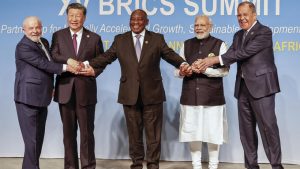
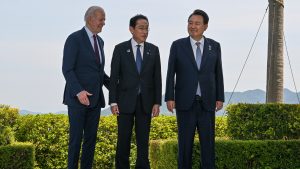
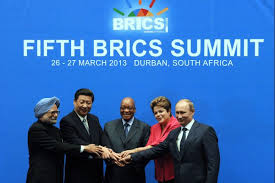
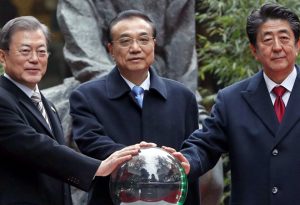 While I have suggested earlier that I don’t think an initial focus on building regional or multilateral institutions is necessarily the best first step in global governance and possibly a means to ‘tone down’ geopolitical competition rhetoric and action, I am now about to contradict myself and this position. For, in the end, there are some obvious regional and international institutions that could encourage collaborative action and push global governance collaboration. And, in fact, I have in mind an obvious one that has – as a current Chinese slang term might well describe it – ‘tang ping’ 躺平 – or ‘lying flat’. It is the Trilateral Summit.
While I have suggested earlier that I don’t think an initial focus on building regional or multilateral institutions is necessarily the best first step in global governance and possibly a means to ‘tone down’ geopolitical competition rhetoric and action, I am now about to contradict myself and this position. For, in the end, there are some obvious regional and international institutions that could encourage collaborative action and push global governance collaboration. And, in fact, I have in mind an obvious one that has – as a current Chinese slang term might well describe it – ‘tang ping’ 躺平 – or ‘lying flat’. It is the Trilateral Summit.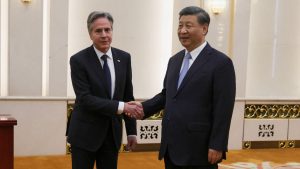 Current diplomatic activity, especially recent visits by senior U.S. officials to China underline the still difficult relations among the major powers. William Burns, the current CIA head, earlier this month described the more tense relations among the major states in international relations in the annual
Current diplomatic activity, especially recent visits by senior U.S. officials to China underline the still difficult relations among the major powers. William Burns, the current CIA head, earlier this month described the more tense relations among the major states in international relations in the annual  So, the International Studies Association (ISA) just concluded in Montreal
So, the International Studies Association (ISA) just concluded in Montreal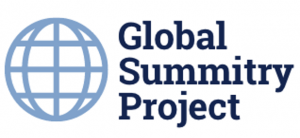
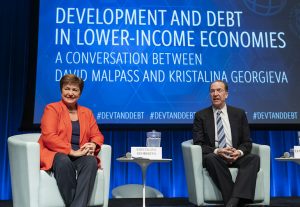 The CWD focused recent attention on the global management of debt and the growing threat of a sovereign debt crisis. After a number of virtual gatherings and much focused discussion, the CWD completed a Debt Management Proposal that CWD passed to folks in India as India scheduled the first G20 Finance Ministers and Central Bankers Ministerial at Bangalore, or its official name, Bengaluru.
The CWD focused recent attention on the global management of debt and the growing threat of a sovereign debt crisis. After a number of virtual gatherings and much focused discussion, the CWD completed a Debt Management Proposal that CWD passed to folks in India as India scheduled the first G20 Finance Ministers and Central Bankers Ministerial at Bangalore, or its official name, Bengaluru.